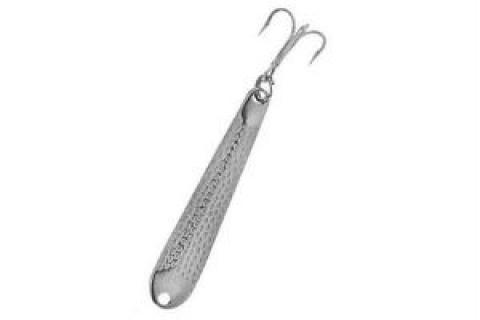
Two goals were foremost in Robert Hopkins' mind when he set out to build a new fishing spoon in the early 1940's. He wanted a lure that would cast for long distances to reach far away gamefish. And he wanted a lure that would fool a wide variety of saltwater species.
 |
| Over half a century later, anglers still turn to the Hopkins Spoon when fish are holding deep over structure and a vertical jigging lure is required. |
Both goals would help in fishing the fertile waters of Chesapeake Bay near his home. But he also hoped the lure would be broadly applicable to other saltwater situations as well. Who knows, perhaps it would even catch on for freshwater fishing.
The offering Hopkins' created, the No=EQL, met both aims. It caught almost every fish he could try it on in saltwater. And he could cast it long distances, even in the teeth of a strong wind and all-too common occurrence on the Chesapeake Bay.
But even though it was a secondary goal, it was in fresh water that the Hopkins spoon really caught fire and became nationally famous. And in that setting, ironically, it wasn't for its ability to cast long distances that the spoon shone. Instead, the Hopkins spoon soon became the go-to lure for vertically jigging. With this technique you don't cast at all, but instead fish right under the boat.
Bass tournament fishermen latched onto the lure for its effectiveness when using that method. But soon anglers found that walleyes, freshwater stripers, white bass, perch, trout, pickerel and pike would also grab these thin, slender spoons with abandon in sweet-water settings.
Today, over half a century later, anglers still turn to the Hopkins Spoon when fish are holding deep over structure and a vertical jigging lure is required. It has a marvelous wounded-shad action and a lifelike appearance as it flutters through the water. The lure's rugged construction is also appealing. It's almost indestructible.
Hopkins' original lures were made from stainless steel knife handles that he ground down and pounded with a hammer. Today the spoons are not cast or stamped out, but are forged from solid stainless steel to ensure the highest quality. The lures are then copper-plated, nickel-plated and finally chrome-plated to obtain the most durable finish possible.
Tactics
These lures will catch virtually all gamefish in fresh or saltwater. They can be cast and steadily retrieved, worked erratically with a pumping motion, trolled or dragged behind a drifting boat over likely fish-holding areas. The top method of all for presenting the lures, however, is to vertically jig them.
Find fish, structure or baitfish on a depth finder. Better still, find all three components. Then lower the lure down to the level of the fish or a foot or two above them. Now pump the Hopkins up and down in a rhythmic motion, between 12 and 36 inches. Watch for strikes as the lure flutters down on the "drop." The line might twitch sideways or you might feel a subtle tap.
Set the hook hard in either case. And hold on tight. The Hopkins is famous for catching BIG fish.
- 5458 views

